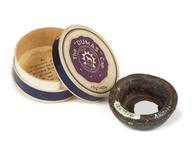





Dilator, injector, Degond, steel, chromium-plated, by Collin of Paris, from Charriere, Collin and Gentile collection, circa 1890
A uterine dilator is used to open the uterus to perform surgical or diagnostic procedures. This example is made of chromium-plated steel and measures 355 mm in length. The instrument was introduced into the cervix with the blades closed and gradually opened up using the screw. Undoubtedly this would have caused the patient discomfort and pain. Made by Collin, a surgical instrument maker based in Paris, a leading French gynaecologist, Dr Paul Segond (1851-1912), is believed to have invented this type of dilator.
Details
- Category:
- Obstetrics, Gynaecology & Contraception
- Collection:
- Sir Henry Wellcome's Museum Collection
- Object Number:
- A606213
- Materials:
- steel, chromium-plated
- Measurements:
-
overall: 92 mm x 128 mm x 94 mm, .15kg
- type:
- uterine dilator
- credit:
- Drouot




